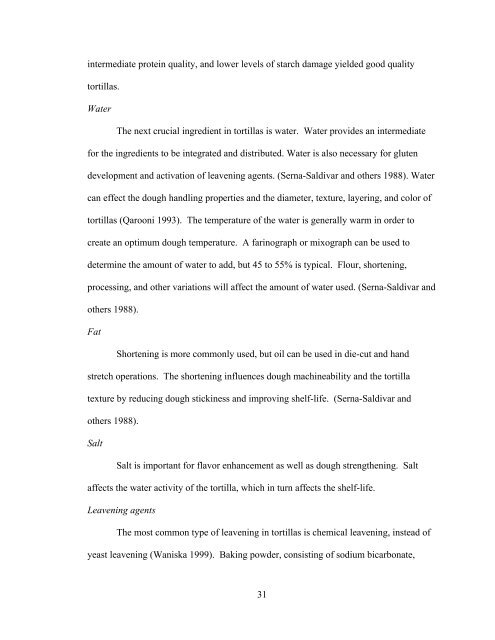EVALUATION OF FOUR SORGHUM HYBRIDS THROUGH THE ...
EVALUATION OF FOUR SORGHUM HYBRIDS THROUGH THE ...
EVALUATION OF FOUR SORGHUM HYBRIDS THROUGH THE ...
You also want an ePaper? Increase the reach of your titles
YUMPU automatically turns print PDFs into web optimized ePapers that Google loves.
intermediate protein quality, and lower levels of starch damage yielded good quality<br />
tortillas.<br />
Water<br />
The next crucial ingredient in tortillas is water. Water provides an intermediate<br />
for the ingredients to be integrated and distributed. Water is also necessary for gluten<br />
development and activation of leavening agents. (Serna-Saldivar and others 1988). Water<br />
can effect the dough handling properties and the diameter, texture, layering, and color of<br />
tortillas (Qarooni 1993). The temperature of the water is generally warm in order to<br />
create an optimum dough temperature. A farinograph or mixograph can be used to<br />
determine the amount of water to add, but 45 to 55% is typical. Flour, shortening,<br />
processing, and other variations will affect the amount of water used. (Serna-Saldivar and<br />
others 1988).<br />
Fat<br />
Shortening is more commonly used, but oil can be used in die-cut and hand<br />
stretch operations. The shortening influences dough machineability and the tortilla<br />
texture by reducing dough stickiness and improving shelf-life. (Serna-Saldivar and<br />
others 1988).<br />
Salt<br />
Salt is important for flavor enhancement as well as dough strengthening. Salt<br />
affects the water activity of the tortilla, which in turn affects the shelf-life.<br />
Leavening agents<br />
The most common type of leavening in tortillas is chemical leavening, instead of<br />
yeast leavening (Waniska 1999). Baking powder, consisting of sodium bicarbonate,<br />
31

















